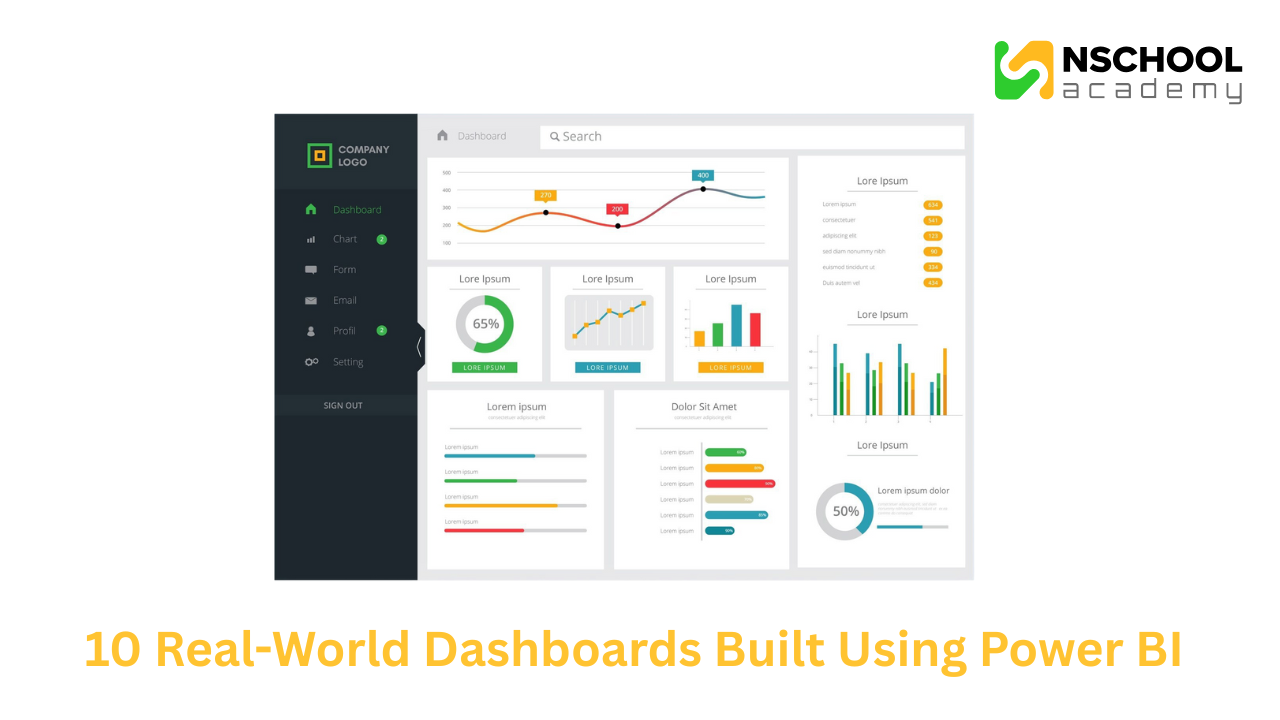10 Real-World Dashboards Built Using Power BI
- July 14, 2025
- nschool
- 0

10 Real-World Dashboards Built Using Power BI
Real-World Dashboards Built Using Power BI From sales and marketing to healthcare and logistics, businesses across industries rely on data to stay ahead. But having data isn’t enough—it’s how you use it that truly matters. Power BI enables professionals to transform complex datasets into clear, interactive dashboards that drive smarter decisions. Let’s take a look at some powerful real-world examples of how organizations are using Power BI dashboards to streamline operations, uncover insights, and deliver measurable value.
1. Sales Performance Dashboard
Use Case: Sales departments, territory managers, and executives use this dashboard to track progress toward revenue targets.
Key Metrics:
- Monthly/quarterly/yearly revenue
- Sales target vs. actual
- Top-performing products
- Regional sales breakdown
Features:
- Trend charts for revenue over time
- Interactive filters for region and product
- Heat maps to visualize sales by geography
Why It Matters:
This dashboard gives immediate visibility into sales effectiveness, highlighting growth opportunities and areas that need corrective action.
2. Marketing Campaign Dashboard
Use Case: Used by digital marketers to analyze cross-channel campaign performance and optimize for conversions.
Key Metrics:
- Impressions and click-through rates (CTR)
- Cost per lead (CPL)
- Conversions by channel
- Return on ad spend (ROAS)
Features:
- Multi-channel analysis (Google, Meta, LinkedIn)
- Funnel visualization
- Filters by campaign duration and platform
Why It Matters:
It allows marketing teams to make data-driven decisions in real-time, improving ROI and reducing wasted ad spend.
3. Financial Overview Dashboard
Use Case: Finance teams use this to monitor overall financial health, cash flow, and budget adherence.
Key Metrics:
- Net profit and loss
- Revenue vs. expenses
- Budget variance
- Cash flow trends
Features:
- Monthly comparisons
- Forecasting using historical data
- Dynamic slicers for department-level reporting
Why It Matters:
Financial dashboards provide critical insights to C-level executives and stakeholders, enabling better planning, auditing, and investment decisions.
4. HR Analytics Dashboard
Use Case: Human Resources departments use this to monitor workforce trends and improve employee retention.
Key Metrics:
- Headcount trends
- Attrition and turnover rates
- Hiring pipeline
- Employee satisfaction scores
Features:
- Demographic breakdowns
- Survey result integration
- Department-level drill-throughs
Why It Matters:
This dashboard helps in talent strategy, diversity and inclusion tracking, and identifying pain points in employee experience.
5. Customer Support Dashboard
Use Case: Support teams rely on this to evaluate the effectiveness and quality of their customer service.
Key Metrics:
- Total and open tickets
- Average resolution time
- First response time
- Customer satisfaction (CSAT, NPS)
Features:
- SLA compliance monitoring
- Trend analysis by issue type
- Agent performance reports
Why It Matters:
Helps in maintaining high customer satisfaction by identifying service bottlenecks and improving team productivity.
6. Retail Store Performance Dashboard
Use Case: Retail managers track the sales, inventory, and operational efficiency of multiple store locations.
Key Metrics:
- Sales per store
- Inventory turnover rate
- Footfall count
- Conversion rate per visitor
Features:
- Geo-based store performance mapping
- Trend lines for daily/weekly sales
- Dynamic benchmarks for comparisons
Why It Matters:
Retailers use these insights to optimize product stocking, forecast demand, and evaluate promotional campaign performance.
7. Healthcare Patient Monitoring Dashboard
Use Case: Hospitals and clinics use this to monitor patient flow, treatment timelines, and facility utilization.
Key Metrics:
- Admission and discharge rates
- Bed occupancy rate
- Average treatment duration
- Resource allocation per department
Features:
- Real-time updates from hospital systems
- Patient categorization by risk level
- Doctor performance tracking
Why It Matters:
Improves healthcare service delivery, enhances patient satisfaction, and supports compliance with health regulations.
8. Project Management Dashboard
Use Case: Project managers and stakeholders use this to monitor project progress, resource allocation, and deadlines.
Key Metrics:
- Project completion percentage
- Milestones achieved
- Budget used vs. allocated
- Team workload distribution
Features:
- Gantt charts and progress bars
- Conditional formatting for overdue items
- Drill-down by project phase
Why It Matters:
Ensures transparency, enhances collaboration, and reduces the risk of scope creep and delays.
9. Supply Chain and Logistics Dashboard
Use Case: Used by logistics and supply chain teams to streamline operations and monitor delivery performance.
Key Metrics:
- Order fulfillment rate
- Delivery time variance
- Inventory aging
- Carrier performance
Features:
- Geo-mapping for delivery zones
- Visual alerts for stockouts
- Lead time tracking over time
Why It Matters:
Improves operational efficiency, reduces overhead costs, and enables proactive issue resolution in complex supply chains.
10. Education Analytics Dashboard
Use Case: Educational institutions and EdTech companies use this to track student engagement and learning outcomes.
Key Metrics:
- Attendance rate
- Assessment scores
- Course completion rate
- Faculty performance metrics
Features:
- Drill-throughs to individual student profiles
- Department and class filters
- Comparison of online vs. offline learning modes
Why It Matters:
Enables personalized learning, identifies struggling students, and supports curriculum improvement through data.
Why Power BI is Ideal for Building Dashboards
Power BI offers a robust set of features for both beginners and advanced users, including:
- Ease of Use:The drag-and-drop interface allows for quick and intuitive report creation.
- Real-Time Data: Supports real-time data streaming and automatic refresh schedules.
- Security: Role-based access, row-level security, and Microsoft compliance.
- Integration: Connects to Excel, SQL Server, Azure, Google Analytics, Salesforce, and many others.
- Customization: The Power BI Visuals Marketplace offers thousands of visuals and customization options.
Whether you’re a small business owner or part of a large enterprise, Power BI makes it easy to bring your data to life.
Conclusion - Real-World Dashboards Built Using Power BI
Power BI dashboards are more than just attractive charts—they help teams make better decisions quickly and clearly. From tracking sales and improving marketing results to enhancing patient care and managing supply chains, Power BI brings real value to all kinds of businesses. If you want to start a career in data or improve how your organization handles reporting, learning Power BI is a smart move. At Nschool Academy, we offer practical, hands-on training designed for students, job seekers, and professionals. Our courses teach you how to connect data, build useful dashboards, and turn complex information into simple, actionable insights.
FAQ
1. What industries benefit the most from Power BI dashboards?
Power BI is industry-agnostic and widely used in finance, healthcare, retail, education, manufacturing, logistics, and IT. Any data-centric business can benefit from its dashboards.
2. Is Power BI free to use?
Power BI Desktop is free for individual use. However, to share reports and dashboards with others via the Power BI Service, you’ll need a Power BI Pro or Premium license.
3. Do I need to know programming to use Power BI?
No. Power BI is designed for users without technical backgrounds. However, learning DAX (Data Analysis Expressions) and Power Query (M) allows for more advanced customization and analysis.
4. How secure is my data in Power BI?
Power BI offers enterprise-grade security, including encryption, identity access management, and row-level security to control who sees what data.

